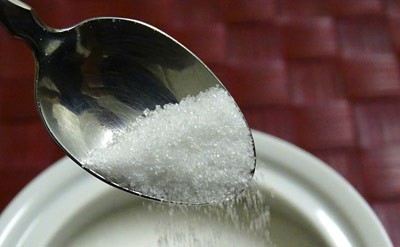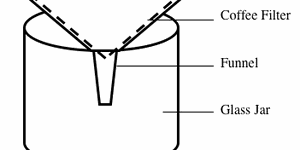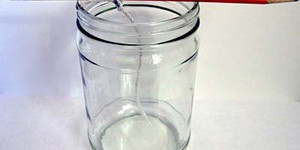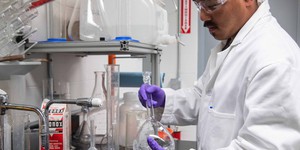Summary
Introduction
Have you ever added a spoon of sugar to your tea and wondered why it disappeared? Where did it go? The sugar did not actually disappear—it changed from its solid form into a dissolved form in a process called chemical dissolution. The result is a tea-sugar mixture in which individual sugar molecules become uniformly distributed in the tea. But what happens if you increase the amount of sugar that you add to your tea? Does it still dissolve? In this science activity, you will find out how much of a compound is too much to dissolve.
Materials
- Distilled water, found in the bottled water section of grocery stores.
Note: You can also use tap water. However, as tap water contains additional ions that have been removed in distilled water, your solubility values may not match the published solubility values. - Measuring cup
- Glasses or cups, 8 oz. (8)
- Spoons (4)
- Measuring spoon (1 teaspoon)
- Epsom salt (150 g)
- Table salt (50 g)
- Table sugar (cane sugar) (250 g)
- Baking soda (20 g)
- Scale
- Marker
- Paper
- Pen
- Optional: thermometer
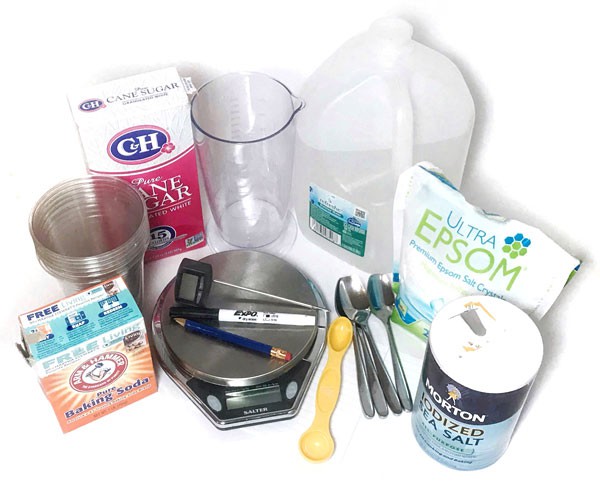 Image Credit: Svenja Lohner, Science Buddies / Science Buddies
Image Credit: Svenja Lohner, Science Buddies / Science Buddies
Prep Work
- Using the marker, label two cups with each compound: "table salt," "table sugar," "baking soda," and "Epsom salt."
- Into one "baking soda" cup, measure 20 grams of baking soda.
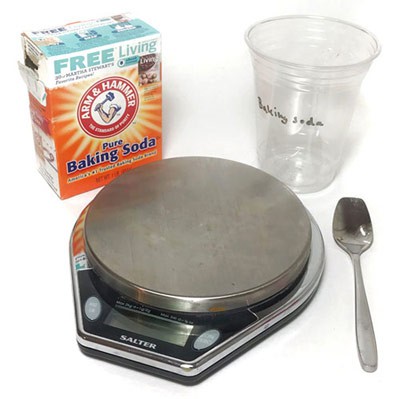 Image Credit: Svenja Lohner, Science Buddies / Science Buddies
Image Credit: Svenja Lohner, Science Buddies / Science Buddies
- Into one "table salt" cup, measure 50 grams of salt.
- Into one "table sugar" cup, measure 250 grams of sugar.
- Into one "Epsom salt" cup, measure 150 grams of Epsom salt.
- Weigh each cup and write down their masses for each one.
- Add 100 mL of distilled water to each of the remaining cups. Use the measuring cup to make sure each cup has the same amount of water. The water should be at room temperature and the same for all cups. You can use a thermometer to verify that.
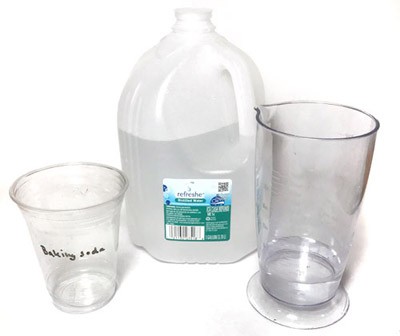 Image Credit: Svenja Lohner, Science Buddies / Science Buddies
Image Credit: Svenja Lohner, Science Buddies / Science Buddies
Instructions
- Take both of the cups you labeled with "baking soda." With the measuring spoon, carefully add one teaspoon of baking soda to the 100 mL of distilled water.
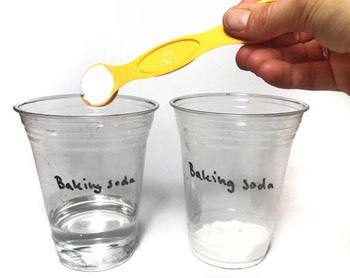 Image Credit: Svenja Lohner, Science Buddies / Science Buddies
Image Credit: Svenja Lohner, Science Buddies / Science Buddies
- Stir with a clean spoon until all the baking soda has dissolved.What do you notice when you stir the solution with baking soda?
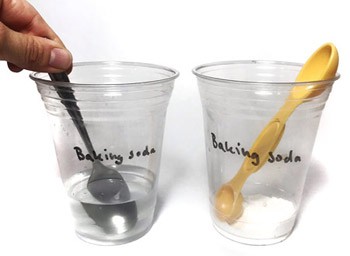 Image Credit: Svenja Lohner, Science Buddies / Science Buddies
Image Credit: Svenja Lohner, Science Buddies / Science Buddies
- Keep adding one teaspoon of baking soda to the water and stirring each time, until the baking soda does not dissolve anymore.How does the solution look when the baking soda does not dissolve anymore?
- Repeat steps 1–3 with both cups labeled "Epsom salt."At what point does the Epsom salt solution become saturated?
- Repeat steps 1–3 with the table salt.How many teaspoons of table salt can you dissolve in 100 milliliters of water?
- Repeat steps 1–3 with the sugar.Could you add more or less sugar compared to the other compounds?
- Put each of the cups containing the remaining solids onto the scale and write down the mass of each one.
- Subtract the measured mass from your initial mass (see Preparation) for each compound.What does the difference in mass tell you about the solubilities of each of the compounds? Which compound is the most or least soluble in distilled water?
Cleanup
What Happened?
Did all of your tested compounds dissolve in distilled water? They should have—but to different extents. Water in general is a very good solvent and is able to dissolve lots of different compounds. This is because it can interact with a lot of different molecules. You should have noticed that sugar had the highest solubility of all your tested compounds (sucrose: about 200 grams per 100 mL of water), followed by Epsom salt (Magnesium sulfate heptahydrate: 113 grams/100 mL), table salt (NaCl: 35.17 g/100 mL), and baking soda (NaHCO3: 9.6 g/100 mL).
This is because each of these compounds has different chemical and physical properties based on their different molecular structures. They are all made of different chemical elements and have been formed by different types of bonding between these. Depending on this structure, it is more or less difficult for the water molecules to break these bonds and form new bonds with the solute molecules to dissolve them.
Digging Deeper
Chemistry is the study of matter and how matter behaves and interacts with other kinds of matter. Everything around us is made of matter, and you can explore the properties of matter using common chemicals around your home. The way that matter behaves is called a property of matter. One important property of matter is called solubility. We think about solubility when we dissolve something in water or another liquid. If a chemical is soluble in water, then the chemical will dissolve, or appear to vanish, when you add it to water. If it is not soluble, or insoluble, then it will not dissolve, and you will still see it floating around in the liquid or at the bottom of the container.
When you dissolve a soluble chemical in water you are making a solution. In a solution, the chemical you add is called the solute and the liquid that the chemical dissolves in is called the solvent. Whether a compound is soluble or not depends on its physical and chemical properties. To be able to dissolve, the chemical has to have the capability to interact with the solvent. During the process of chemical dissolution, the bonds that hold the solute together need to be broken, and new bonds between the solute and solvent have to be formed. For example, when adding sugar to water, the water (solvent) molecules are attracted to the sugar (solute) molecules. Once the attraction becomes large enough, the water is able to pull individual sugar molecules from the bulk sugar crystals into the solution. Usually, the amount of energy it takes to break and form these bonds determines if a compound is soluble or not.
Generally, how much of a chemical you can dissolve in a specific solvent is limited. At some point, the solution becomes saturated. This means that if you add more of the compound, it will not dissolve anymore and will stay solid instead. This amount is dependent on molecular interactions between the solute and the solvent.
Ask an Expert
For Further Exploration
- Does the solubility change if you use a different solvent? Repeat the same experiment, but instead of using distilled water, use rubbing alcohol, vegetable oil, or nail polish remover as solvent. How does this change your results?
- Can you find other substances or chemicals that you can dissolve in distilled water? How do their solubilities compare to the compounds you have tested?
- Solubility of compounds is also highly dependent on the temperature of the solvent. Do you think you can dissolve more salt or sugar in hot or cold water? Test it to find out!


